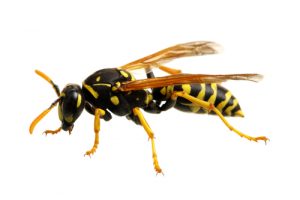Yellowjackets Inside Houses!
By Chris Williams on October 7, 2011.
We think of yellowjackets nesting outside in the ground or up in trees. Fact is, more and more, yellowjackets are nesting in houses. If you’re lucky, you’ll never be confronted by them.
Yellowjackets (usually the German yellowjacket) will nest in voids inside an interior or outer wall of a building, in ceiling void insulation, even under a floor. They’ll enter wherever they can find an opening on the outside. The nest entrance can be a chink in mortar, a hole at an outside conduit or around a dryer vent or attic fan, an opening where a window frame meets a wall, a loose-fitting soffit, or a damaged chimney flange.
Although you may have found the entrance to a yellowjacket nest in your home, that doesn’t mean you’ve found the nest. That’s the tricky part when it comes to trying to kill the yellowjackets in the nest; the nest itself can be 6 inches or 30 feet from the opening. You’ll want a professional to do this job! Sometimes, a failed insecticide treatment can cause yellowjackets to chew their way out into living areas.
 Nests inside building voids are usually about the size of a basketball, but can grow ten times larger. They are irregularly shaped to fit the void space. Yellowjacket nests will continue to grow throughout the summer until activity drops off in September, and after the first hard frost, the yellowjackets in the nest should be dead.
Nests inside building voids are usually about the size of a basketball, but can grow ten times larger. They are irregularly shaped to fit the void space. Yellowjacket nests will continue to grow throughout the summer until activity drops off in September, and after the first hard frost, the yellowjackets in the nest should be dead.
After you’ve had a pest control company kill the yellowjackets in the nest, the next question is should you have the nest removed from the void? If the nest is left in place, you could have temporary odor problems from rotting larvae in the nest and you could get scavenging pests like silverfish and dermestid beetles that are attracted to the nest. The good news is that old nests aren’t reused by yellowjackets the following year.
Yellowjacket removal can be expensive if walls and ceilings must be opened up, and especially so if you’re not sure exactly where the nest is located. The cost and damage may not be justified. The exception might be if you know where the nest is and it’s readily accessible, if the nest is easily removable, or if the nest is very large. In a worst case scenario, yellowjackets have chewed through an interior wall or ceiling and emerged inside the house. In this case, there is already damage that needs repair so it makes sense to remove the nest at the same time.
Time of year makes a difference, too. A nest that is treated during summer when it is most active will have a larger number of developing larvae inside which will rot and cause an odor problem or attract insects. A nest treated in late summer or fall will be mostly empty with no larvae and fewer workers to cause odor problems.